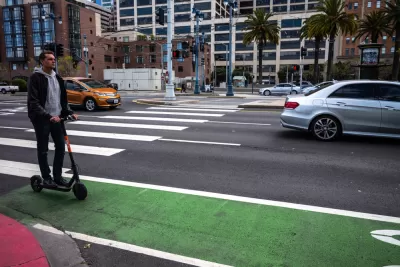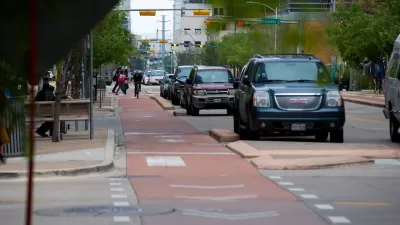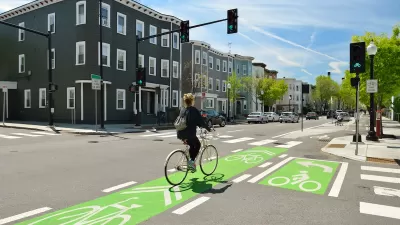With the popularity of electric scooters, it seems like non-automobile travel is gaining a large new constituency. Making room for scooters raises big questions of infrastructure that might not be answered first by nomenclature.

"In a matter of months, electric scooter companies have set up fleets in dozens of American cities," writes Angie Schmitt to raise a big question. "Where do these vehicles belong on our streets?"
"The most logical place for them seems to be bike lanes. That’s how scooter firm Bird sees it — the company wants to help cities build bike lanes so its customers can safely ride in the street without impeding people on sidewalks," according to Schmitt.
But bike lanes are for bikes, and many opponents of bike infrastructure complain about how seldom they are used. But with this new mode taking to the streets and proving very popular, perhaps it's time to completely reframe the bike lane.
Jarrett Walk suggests in a recent blog post that we rethink the different kinds of lanes on the street after carefully considering their defining qualities. The key characteristics to consider: speed and width.
All this came up because I was trying to think of the correct new term for “bike lane” as we proliferate more vehicle types that run more or less at the speed and width of bicycles but are clearly not bicycles, such as electric scooters. The two logical terms seem to be narrow lane or midspeed lane. One way or another the two concepts will need to track with each other.
FULL STORY: Do We Need a New Theory and Name for “Bike Lanes”?

Alabama: Trump Terminates Settlements for Black Communities Harmed By Raw Sewage
Trump deemed the landmark civil rights agreement “illegal DEI and environmental justice policy.”

Planetizen Federal Action Tracker
A weekly monitor of how Trump’s orders and actions are impacting planners and planning in America.

The 120 Year Old Tiny Home Villages That Sheltered San Francisco’s Earthquake Refugees
More than a century ago, San Francisco mobilized to house thousands of residents displaced by the 1906 earthquake. Could their strategy offer a model for the present?

BLM To Rescind Public Lands Rule
The change will downgrade conservation, once again putting federal land at risk for mining and other extractive uses.

Indy Neighborhood Group Builds Temporary Multi-Use Path
Community members, aided in part by funding from the city, repurposed a vehicle lane to create a protected bike and pedestrian path for the summer season.

Congestion Pricing Drops Holland Tunnel Delays by 65 Percent
New York City’s contentious tolling program has yielded improved traffic and roughly $100 million in revenue for the MTA.
Urban Design for Planners 1: Software Tools
This six-course series explores essential urban design concepts using open source software and equips planners with the tools they need to participate fully in the urban design process.
Planning for Universal Design
Learn the tools for implementing Universal Design in planning regulations.
Clanton & Associates, Inc.
Jessamine County Fiscal Court
Institute for Housing and Urban Development Studies (IHS)
City of Grandview
Harvard GSD Executive Education
Toledo-Lucas County Plan Commissions
Salt Lake City
NYU Wagner Graduate School of Public Service





























